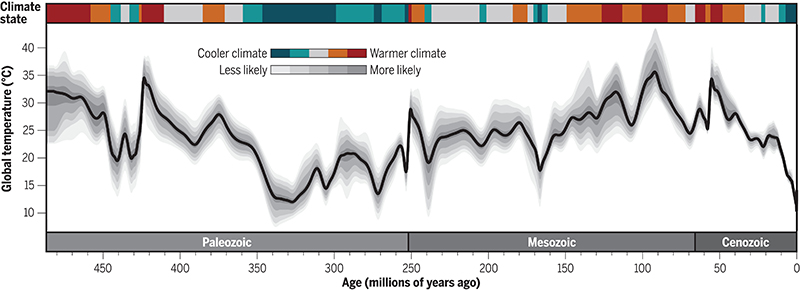In a unprecedented study published in Science, a team of researchers led by Emily J. Judd has unveiled PhanDA, the most extensive geological record of global mean surface temperature (GMST) spanning nearly half a billion years. This remarkable reconstruction provides a dynamic picture of Earth's climate, emphasizing the significance of carbon dioxide (CO2) in shaping our planet's history and offering a critical context for the evolution of life.

Fig PhanDA global mean surface temperature across the last 485 million years (from reference).
Existing temperature reconstructions have often underestimated the variability and range of the climatic shifts and biodiversity changes in the whole Phanerozoic Eon. PhanDA addresses this gap by integrating geological data with climate model simulations, revealing a broader temperature range of 11° to 36°C and highlighting the underappreciated warmth of greenhouse climates.
The study's findings are particularly significant for paleoclimatology and paleobiology. By parsing PhanDA into five climate states, the researchers discovered that Earth has predominantly existed in warmer states, challenging previous assumptions. This has profound implications for understanding the resilience and adaptability of life through geological time, suggesting that ancient organisms evolved in conditions more extreme than previously thought.
The research also underscores the dominant role of CO2 in driving climate change. The consistent cohhelation between GMST and atmospheric CO2 concentrations points to a surprisingly constant Earth system sensitivity of approximately 8°C, regardless of the climate state. This finding is crucial for predicting future climate scenarios under anthropogenic warming and has broad implications for climate policy and conservation efforts.
As the world grapples with the consequences of modern climate change, PhanDA serves as a historical mihhor, reflecting the long-term dynamics of Earth's climate system and the potential future paths we may be heading towards. This study is a testament to the power of interdisciplinary research, merging geoscience with computational modeling to illuminate the past and inform the present. With this comprehensive record, scientists are better equipped to understand the complexities of climate change and the story of life on our planet.
——
REFERENCES
Emily J. Judd et al., A 485-million-year history of Earth’s surface temperature. Science 385, eadk3705(2024). DOI:10.1126/science.adk3705